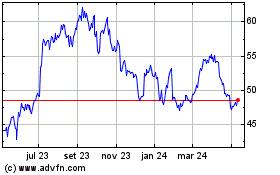Stock Market News for June 1, 2011 - Market News
01 Junho 2011 - 6:06AM
Zacks
After a volatile trading session, indices finally ended with modest
gains buoyed by optimism over Greece’s new plans to tackle its debt
crisis. However, on a monthly basis, benchmarks were left lingering
in the red. Markets had dropped down during the session as weak
economic data weighed on investor sentiment, but rebounded ahead of
the close and almost touched the levels benchmarks were closing in
on in the morning.
The Dow Jones Industrial
Average (DJIA) was up 1.0% to close at 12,569.79. The Standard
& Poor 500 (S&P 500) closed with gains of 1.1% at 1,345.20.
The Nasdaq Composite Index climbed up 1.4% to settle at
2,835.30. The
fear-gauge CBOE Volatility Index climbed above 16. On the New York
Stock Exchange, AMEX and Nasdaq, consolidated volumes were 8.2
billion shares compared with last year's daily average of 8.47
billion. The benchmarks recorded their fourth consecutive week of
losses for the week ending May 27 and also ended in the red for the
month of May. For May, the Dow, S&P 500 and Nasdaq dropped
1.9%, 1.3% and 1.4%, respectively. This was also the worst monthly
performance for the S&P 500 since last August.
As reports made the rounds
that European Officials, particularly Germany, have agreed to move
away from their earlier demand making way for a new loan package
for debt-ridden Greece, investor sentiment gained strength. This
development pulled US indices out of the gloom created by weak
economic data and also lifted global shares. According to the Wall
Street Journal, Germany “is considering dropping its push for an
early rescheduling of Greek bonds in order to facilitate a new
package of aid for Greece.” This will expectedly delay Greece’s
debt restructuring. European Officials are considering a second
bailout package.
Though the day ended with
modest gains, larger concerns still remain about the economic
recovery. Economic data that was released on Tuesday all showed a
negative trend with consumer confidence declining, US single family
home prices dropping below their 2009 level and US Midwest business
activity growing at a
slower rate.
The consumer confidence index
declined for the month of May after an improvement in April. The
Conference Board reported the consumer confidence index has dropped
to 60.8 in May from 66.0 in April. The Present Situation Index and
the Expectations Index declined to 39.3 from 40.2 and to 75.2 from
83.2, respectively. Inflationary worries and concerns about the
employment situation were reasoned to have led to the declines.
Lynn Franco, Director of The Conference Board Consumer Research
Center, said: “A more pessimistic outlook is the primary reason for
this month’s decline in consumer confidence. Consumers are
considerably more apprehensive about future business and labor
market conditions as well as their income prospects. Inflation
concerns, which had eased last month, have picked up once again. On
the other hand, consumers’ assessment of current conditions
declined only modestly, suggesting no significant pickup or
deterioration in the pace of growth.”
The S&P/Case-Shiller Home
Price Indices declined below their 2009 level, a period when the
economy was reeling under a recession. The 20-city index that
tracks changes in home prices throughout the United States was at
138.16 compared to the April 2009 low of 139.26. The 20-city index
had sunk 0.2% in March from February.
Meanwhile, the Institute for
Supply Management-Chicago reported that the Chicago Purchasing
Managers Index has dropped to 56.6 in May from 67.6 in April. The
index is a regional indicator of the economic health of the
manufacturing sector in Illinois, Indiana and Michigan. The index
dropped more than the estimate of a drop to 62.6. The index is
based on five major indicators: new orders, inventory levels,
production, supplier deliveries, and the employment environment. A
reading above 50 represents expansion of the manufacturing sector,
compared to the previous month.
On a sectoral basis, energy
stocks had a volatile run as crude prices shifted between gains and
losses. The energy sector was at its highest level since 2008 going
into May. Crude prices have fluctuated from a high of $115 to
levels below the $100 per barrel mark. The sector has consequently
felt the burn but still remains in the positive zone. For the
month, sweet crude had dropped 9.9% and on Tuesday, crude prices
jumped 2% to settle at $102.70 per barrel. Gainers for this sector
for the day include Chevron Corp. (NYSE:CVX), BP plc (NYSE:BP),
Transocean Ltd. (NYSE:RIG), Schlumberger Limited (NYSE:SLB) and
Exxon Mobil Corporation (NYSE:XOM) and they surged 1.7%, 1.5%,
0.5%, 1.2% and 1.0%, respectively.
The technology sector also
pushed the markets up, with Cisco Systems, Inc. (NASDAQ:CSCO) being
one of the leading gainers among the Dow components as it surged
2.1%. Other gainers included Apple Inc. (NASDAQ:AAPL), Google Inc.
(NASDAQ:GOOG), Microsoft Corporation (NASDAQ:MSFT), Intel
Corporation (NASDAQ:INTC) and Hewlett-Packard Company (NYSE:HPQ)
and these share were up 3.1%, 1.6%, 1.0%, 1.4% and 1.1%,
respectively.
APPLE INC (AAPL): Free Stock Analysis Report
BP PLC (BP): Free Stock Analysis Report
CISCO SYSTEMS (CSCO): Free Stock Analysis Report
CHEVRON CORP (CVX): Free Stock Analysis Report
GOOGLE INC-CL A (GOOG): Free Stock Analysis Report
HEWLETT PACKARD (HPQ): Free Stock Analysis Report
INTEL CORP (INTC): Free Stock Analysis Report
MICROSOFT CORP (MSFT): Free Stock Analysis Report
TRANSOCEAN LTD (RIG): Free Stock Analysis Report
SCHLUMBERGER LT (SLB): Free Stock Analysis Report
EXXON MOBIL CRP (XOM): Free Stock Analysis Report
Zacks Investment Research
Schlumberger (NYSE:SLB)
Gráfico Histórico do Ativo
De Jun 2024 até Jul 2024

Schlumberger (NYSE:SLB)
Gráfico Histórico do Ativo
De Jul 2023 até Jul 2024
